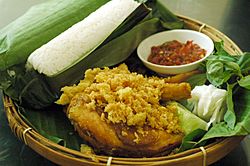Nasi timbel facts for kids

Nasi timbel rice dish with ayam penyet.
|
|
| Course | Main course |
|---|---|
| Place of origin | Indonesia |
| Region or state | Bandung, West Java |
| Serving temperature | Hot |
| Main ingredients | Hot steamed rice wrapped in banana leaf surrounded with side dishes |
Nasi timbel is a yummy and warm dish from Indonesia. It's made with steamed rice that's carefully wrapped in a banana leaf. This special dish comes from West Java, a region known for its delicious Sundanese cuisine. When the hot rice touches the banana leaf, it creates a wonderful, unique smell. It's a bit like making lontong, where rice is pressed and rolled in banana leaves. Nasi timbel is a full meal, served with many tasty side dishes!
Contents
What is Nasi Timbel?
Nasi timbel is a traditional Indonesian meal. The main part is the steamed rice, which is cooked until it's soft and fluffy. Then, it's wrapped tightly in a fresh banana leaf. This isn't just for looks! The banana leaf gives the rice a special, earthy smell and taste. It's a very popular dish, especially in the West Java area of Indonesia.
How is Nasi Timbel Made?
Making nasi timbel starts with cooking the rice. Once the rice is hot and ready, it's carefully placed onto a clean banana leaf. The leaf is then folded and rolled tightly around the rice. This helps to shape the rice and keep it warm. The heat from the rice makes the banana leaf release its natural oils, which adds to the dish's unique flavor.
What Comes with Nasi Timbel?
Nasi timbel is rarely eaten alone. It's usually served as a complete meal with many different side dishes. These sides make the meal exciting and full of flavor. Some common things you might find with your nasi timbel include:
- Fried Chicken: Crispy and delicious chicken pieces.
- Empal Gepuk: This is fried beef that's been pounded flat and seasoned.
- Jambal Roti: A type of salted fish that adds a savory taste.
- Tahu Goreng: Fried tofu that's soft inside and crispy outside.
- Tempeh: A traditional Indonesian food made from fermented soybeans, often fried.
- Salted Duck Egg: A unique and salty addition to the meal.
- Sayur Asem: A sour and spicy vegetable soup.
- Lalab: Fresh raw vegetables, like cucumber or cabbage, for a refreshing crunch.
- Sambal: A spicy chili sauce that adds a kick to every bite!
These side dishes are chosen to create a balanced and tasty meal, with different textures and flavors.
Nasi Timbel's History
Nasi timbel has been a part of Sundanese cuisine for a very long time. It's a dish that shows how people in Indonesia use local ingredients, like banana leafs, in clever ways. Wrapping food in leaves is a common practice in many traditional Indonesian dishes. It helps to keep food fresh and adds flavor.
Evolution to Nasi Bakar
Over time, some dishes change and evolve. Nasi timbel is a great example of this! It later inspired another popular Indonesian dish called nasi bakar. While nasi timbel is steamed rice wrapped in a banana leaf, nasi bakar takes it a step further. Nasi bakar is also rice wrapped in a banana leaf, but then it's grilled or "bakar" (which means "burnt" or "grilled" in Indonesian) over charcoal. This grilling gives the rice an even smokier and more intense flavor from the banana leaf.
Why is Nasi Timbel Special?
Nasi timbel is special for a few reasons. First, the use of the banana leaf is unique. It's not just a wrapper; it's an ingredient that adds to the taste and smell. Second, it's a complete meal in one package, offering a variety of flavors and textures. It's a dish that brings people together and is a big part of Indonesian food culture.

